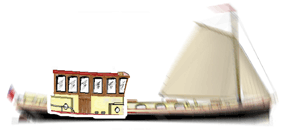 |
|
 |
|
 |
Bathroom <> Bow-Locker <> Build-Story <> Cloakroom <> Deck-Area <> Drive-Steering <> Electrics-Room <> Engine-Room <> Hallway <> Kitchen/Galley <> Lounge/Saloon <> Master-Bedroom <> Rear-Storage <> Spud-Leg <> Study/Bedroom <> Tech-Specs |
| The key use and need for a wheelhouse is... navigation. Originally, barges were navigated from the rear of the vessel where the Captain heaved on a large wooden tiller to steer his course whilst the elements threw at him, what they might! Progress bought him comparative luxury by way of a wheelhouse for weather protection. This new found luxury gave its name to a new type of motor powered barge called, a Luxemotor. These wheelhouses were originally open backed they were eventually enclosed and offered the captain and his small crew a preferable place to sleep. |
PORT SIDE
STARBOARD SIDE |
For live-aboard purposes we have progressed the use of the wheelhouse by; moving it a cabins-length forward towards the bow and thanks to hydro-mechanical steering equipment, we could place a steering wheel wherever we liked. This forward wheelhouse position offers a better view of the bow and inconsequence, improves ones ability to navigate. On JENAL, we have made the wheelhouse even larger and evolved it into a multi-functional room, similar to the conservatory attached to a house. The prime difference being, ours is on top! |
|
Wheelhouses by their very nature, stick up above the barges
superstructure to aid navigation. This obvious positive is also a negative, where low
bridges are concerned. So, the collapsible wheelhouse was invented. Made of
hardwood, usually from mahogany or teak, and with the largish roof split
up into a
series of removable panels to aid manhandling. The inordinate dismantling process required time
to fold the fore & aft screens, remove all the window sections, dismantle the
roof and finally... safely store all these loose and expensive components.
This inordinate process was and is no fun, especially when it's windy and wet.
We side-stepped this hassle-filled problem by constructing our wheelhouse from aluminium and cleverly hand-painted it to look like it's teak and blend with the period style. |
|
JENAL's chosen 'curve topped' window design is glazed
with 40% solar-heat reflective double glazing and
thermal breaks between inner and outer frames to stop condensation. The
roof and side window assemblies are one structure, the fore & aft
screens unclip & hinge downward on cantilevered arms, coming to rest on the superstructure roof
sections as the roof lowers. A large sliding roof hatch (sun-roof) above the steering and
navigation centre slides back and a push-button operated hydraulic ram
system, attached to 8
cables, lowers the roof and side structure as one unit. JENAL is
then piloted standing through the hatch, remembering to duck if the
bridge is particularly low. A small pennant mast on the bow, some 10cms higher than the erect wheelhouse acts as our low bridge warning indicator. This same pennant mast mounting-point, doubles as a mount for the forward searchlight. |
||
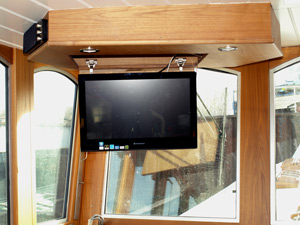 |
 |
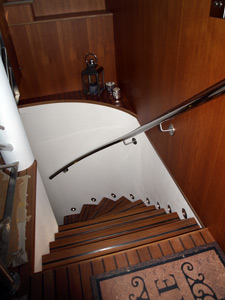 |
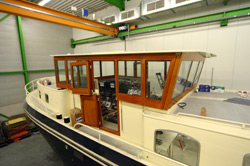 |
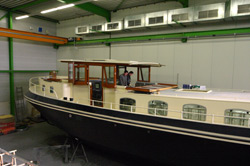 |
 |
 |
|||
| erect aluminium wheelhouse (square topped design) | screens and corners folded | total of 5 minutes to lower | JENAL's curved top design |
| HOME <> SITE MAP <> CONTACT US <> ABOUT US <> PUBLIC PRESENTATIONS <> JENAL DIARY <> SUPPLIER CONTACTS <> DUTCH BARGE ASSOCIATION |